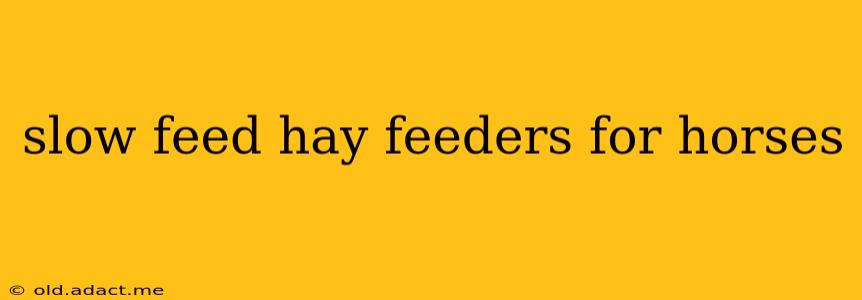Slow feed hay feeders for horses are becoming increasingly popular among horse owners concerned about their equine companions' digestive health and overall well-being. These innovative feeders are designed to encourage slower eating habits, mimicking a horse's natural grazing behavior. This approach offers numerous benefits, ranging from improved digestion and reduced weight gain to better dental health and decreased boredom. But with so many options on the market, choosing the right slow feeder can feel overwhelming. This comprehensive guide will help you understand the advantages, different types, and considerations when selecting a slow feed hay feeder for your horse.
Why Choose a Slow Feed Hay Feeder?
The primary benefit of a slow feeder lies in its ability to slow down a horse's eating rate. Horses evolved to graze continuously throughout the day, consuming small amounts of forage over extended periods. The rapid consumption of hay from traditional feeders can lead to several problems:
- Digestive Issues: Fast eating can overload the digestive system, potentially leading to colic, ulcers, and other gastrointestinal problems.
- Weight Gain: Consuming large quantities of hay quickly can contribute to weight gain, especially in horses prone to obesity.
- Dental Problems: Rapid consumption can put excessive strain on the teeth, potentially leading to dental issues.
- Boredom and Stress: Horses can become bored and stressed when they finish their hay quickly, leading to vices like cribbing or wood chewing.
Different Types of Slow Feed Hay Feeders
Slow feed hay feeders come in a wide variety of designs, each with its own advantages and disadvantages. Here are some of the most common types:
-
Net Feeders: These are essentially large nets filled with hay. The mesh size controls the rate of hay release, forcing the horse to pull out small amounts at a time. They are relatively inexpensive and portable but can sometimes be difficult to clean thoroughly.
-
Hay Bags: Similar to net feeders, hay bags use a fabric material to slow down hay consumption. They are often durable and easy to hang, but the size and type of hay can influence their effectiveness.
-
Slow Feed Troughs: These are designed with various internal structures, such as dividers or small holes, to regulate the hay flow. They are typically more stable than net feeders and bags and are easier to clean.
-
Puzzle Feeders: These feeders are designed to challenge the horse mentally and physically, requiring them to work for their food. They often incorporate various shapes, compartments, and obstacles to slow down eating and encourage natural foraging behaviors.
-
Hay Nets with Different Mesh Sizes: The mesh size significantly influences how quickly the horse can access the hay. Smaller mesh sizes create a slower release, while larger mesh sizes allow for faster consumption.
What Size Slow Feed Hay Feeder Do I Need?
The size of the slow feed hay feeder you need depends on several factors:
- The size of your horse: Larger horses will naturally require larger feeders to ensure they have enough hay for a reasonable duration.
- The type of hay: Some hays are denser than others, affecting how much fits into a feeder and how long it takes to consume.
- Your horse's eating rate: Observe your horse's eating habits to determine how long it takes them to consume a standard amount of hay. This will help you choose a feeder that provides the appropriate slow-release.
- The feeding frequency: If you plan to refill the feeder several times a day, you may not need as large of a feeder compared to those refilled only once per day.
How to Introduce a Slow Feed Hay Feeder
Introducing a new slow feed hay feeder should be a gradual process. Sudden changes can stress your horse and disrupt their eating habits. Start by providing a small amount of hay in the new feeder alongside their regular feeding method. Gradually increase the amount of hay in the slow feeder over several days to allow your horse to adjust.
Maintaining Your Slow Feed Hay Feeder
Proper maintenance is crucial to ensuring the longevity and hygiene of your slow feed hay feeder. Regular cleaning is essential to prevent mold and mildew growth. Thoroughly rinse the feeder with water and allow it to air dry completely before refilling it with hay.
Are Slow Feed Hay Feeders Right for My Horse?
Slow feed hay feeders offer significant benefits for many horses, particularly those prone to weight gain, digestive issues, or boredom. However, it's important to consider your horse's individual needs and consult with your veterinarian before making a change to their feeding routine. They can advise you on the best type of feeder and help you monitor your horse's progress.
By carefully considering the different types of slow feed hay feeders and their associated benefits, you can make an informed decision that supports your horse's health and well-being. Remember that a gradual transition and consistent monitoring are crucial for successful implementation.
